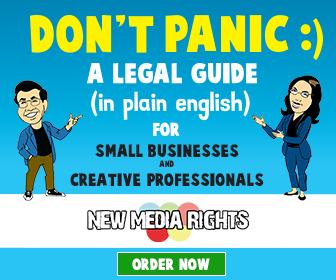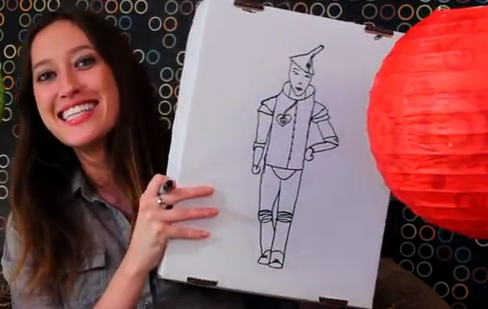Submitted by New Media Rights last modified Tue, 10/27/2020 - 8:53pm
What types of things are protected by copyright?
Although we’ve been using common types of creative works like books, movies and songs as examples so far, copyright protects an extremely wide range of creative expressions in eight categories.
Here’s a quick overview.
(1) Literary works
Includes books, newspaper articles, and blog posts. Even your last email would be considered a literary work. The definition of literary works is so broad it even includes computer programs.
(2) Musical works
Includes musical notations of all kinds. The famous guitar notes that make up the intro to Stairway to Heaven is considered a musical work.
(3) Dramatic works
Includes plays, screenplays, and TV scripts.
(4) Choreographic works
Includes dances, ballets, and mime performances.
(5) Pictorial, graphic, and sculptural works
Includes paintings, drawings, photographs, and digital illustrations.
(6) Motion pictures and other audiovisual works
Includes movies, live webcasts that are being saved, slideshows, and video podcasts.
(7) Sound recordings
While the musical notes that make up a song is protected as a musical work, the actual recording of that performed notation is protected as a sound recording. Sound recordings are a distinct and independent category from musical recordings because they also includes everything that can be recorded and reproduced that isn’t music, including speeches, sound effects, and audio books.
(8) Architectural worksBuildings that have elements that meet the general requirements for protection particularly if they have sufficiently original design elements and designs that are independent of the utilitarian purposes of the building, can be protected by copyright law.
Now that you understand the basics, we can discuss this in more detail.
(1) Literary works
“Literary works” are defined in Section 101 of the Copyright Act as “works, other than audiovisual works, expressed in words, numbers, or other verbal or numerical symbols or indicia, regardless of the nature of the material objects, such as books, periodicals, manuscripts, phonorecords, film, tapes, disks, or cards, in which they are embodied.”
This is a catch-all term to cover almost every written creative work imaginable. It covers all works that are traditionally thought of as “literature,” such as novels, poems, stories, essays, etc.
It also includes very non-literary types of works like catalogs, reference books and databases, to the extent that they meet the originality requirements necessary for copyright protection. On the Internet, this definition includes emails, blog posts, posts on online forums, and even computer programs.
(2) Musical works, including any accompanying words
“Musical works" include the instrumental component of the work as well as any accompanying words. Copyright of musical works includes both the author of the lyrics and music notation, as well as the performer.
Musical works are especially worth looking at because Section 115 of the Copyright Act specifically makes them subject to “compulsory licensing” once they have been released to the public. These compulsory licenses allow any musician to perform or record a cover version of a song without getting permission from the original songwriter. The original musicians cannot deny the use of their music if the fees are paid even if they hate the idea of their song being covered.
This is one reason why karaoke versions of songs can be readily made and released. The fact that artists can’t deny anyone with money from covering their songs is probably why there’s a Kidz Bop version of Modest Mouse’s “Float On."
There is no compulsory license system with literary works. A playwright, for example, can deny others the ability to perform her play even if someone is willing to pay for the rights to the play.
Note that permission does need to be granted if another artist wants to “sample” a song (i.e., taking portions of the original song without recreating/rerecording the portions taken).
(3) Dramatic works, including any accompanying words
“Dramatic works” includes plays, screenplays, and TV scripts. This category illustrates how works can overlap into many different categories. The musical score to dramatic works like movies can be copyrighted separately. Audio recordings of books can be considered sound recordings.
Screenplays that movies are made from can also be considered literary works.This overlap illustrates a major point about copyright law. In order to figure out exactly what your rights are, you first have to figure out what exactly what the work is that you’re trying to protect.
(4) Pantomimes and choreographic works
“Pantomimes and choreographic works” includes ballets, dances, or mime performances. Since copyright protection requires that a work be fixed in a permanent, reproducible way, these works are often fixed when they are videotaped, photographed, or notated in shorthand for choreography. To be eligible for copyright protection, a choreographic work or pantomime must be described in sufficient detail to enable the work to be performed from that description.
An interesting thing to note about this category is that folk dances and traditional dances are not protectable.
(5) Pictorial, graphic, and sculptural works
“Pictorial, graphic, and sculptural works” includes traditional art, such as paintings, drawings, prints and sculptures as well as illustrations, art reproductions, plans and drawings, and photographs. It also includes useful objects like maps, charts, globes as well as the book and magazine designs and advertising art.
As long as a pictorial work meets the low level of originality needed for protection, every work can be protected no matter how poor the artistic quality of the work actually is. Luckily for your untalented artist friends, the life’s work of the greatest modern painter gets the same amount of protection as the concert photo you took with your cell phone camera.
Graphic works—particularly utilitarian ones like maps and charts—often run into the problem that copyright does not protect utilitarian objects or language. The fact that copyright doesn’t protect purely functional designs is why clothing designs are almost never protected by copyright. Sculptural works that are primarily utilitarian don’t receive copyright protection either. One of the reasons stoves, coffee makers, and refrigerators all look so much alike may be partly because appliance designs don’t often get copyright protection.
(6) Motion pictures and other audiovisual works
When you think of an "audiovisual work," think of a movie, which combines both images (visual) and recorded sound (audio). The category of "audiovisual works" includes movies but isn't limited to them. Instead, "audiovisual work" can include everything from movies to slideshows to video podcasts—in other words, anything that is meant to be shown (be it on a projector, TV or computer screen) that consists of recorded sound and images. It doesn't matter what format the work is in, whether it's a VHS tape, 35mm film or digital file.
(7) Sound recordings
Sound recordings are defined by the Copyright Act as "works that result from the fixation of a series of musical, spoken, or other sounds, but not including the sounds accompanying a motion picture or other audiovisual work.” Probably the best way to understand the sound recording category is to compare it to the “musical works” category.
Sound recordings are completely distinct and independent from “musical works.” A musical work consists of the music’s notation—the melody and harmony as well as any accompanying lyrics as composed by the composer.
By contrast, an actual recording of the song onto a physical medium (the CD, tape, mp3 file, etc.) is considered a sound recording. The protectable parts of the sound recording could include the way the song is sung by the vocalist, played by the instrumentalists, arranged by the producer, and mixed by the recording engineer.
If you need an example, think about it this way: one musical work can be made in multiple sound recordings. Every artist who decides to record a cover of Bob Dylan’s song “Like a Rolling Stone” makes their own sound recording of that single musical work.
If you make a sound recording of a musical work, this is an example of a derivative work.
Finally, it may be worth learning one of the often-used buzzwords associated with sound recordings: the “phonorecord.” A phonorecord is the physical object in which sound recordings are embodied. Common examples of phonorecords include cassette tapes, CDs, vinyl LPs, and DVDs.
(8) Architectural works
Architectural works are probably the least expected category of works protected by copyright law. The architectural work category protects the design of a building in architectural blueprints, architectural drawings, and even buildings themselves. For this category, copyright can protect the work’s overall form as well as the arrangement and composition of spaces and elements in the design. On the other hand, it doesn’t protect the standard features that make buildings habitable and the utilitarian aspects that make it useful.
The phrase “arrangement and composition of spaces and elements” recognizes that creativity in architecture frequently takes the form of a selection, coordination, or arrangement of unprotectable elements into an original, protectable whole. For example, homes are often a simple collection of standard and utilitarian elements such as bathrooms, doorways, kitchens, and hallways. Yet, when architects arrange these elements in novel ways, they create a work deserving of protection.
To receive protection, architectural works must contain original design elements, like a sufficiently original overall shape and interior design. As long as these designs aren’t simply there for functional purposes (like to keep the roof from collapsing on itself, or to comply with housing regulations), the work is protectable.
Conclusion
If you haven’t noticed, all of these categories in practice are relatively broad and amorphous. The nature of creative work is that it can take almost any form, so the scope of the copyright law was drafted in such a way to take that into account. The categories that works can potentially be protected in are so wide that it’s difficult to imagine what types of creative work are not protected.
If you have questions about what category of work you work might fall under, or if you’re having trouble filling out your copyright filing application with the correct category, feel free to contact New Media Rights via our contact form to find out whether you qualify for free or reduced fee legal services. We also offer competitive full fee legal services on a selective basis. For more information on the services we provide click here.




